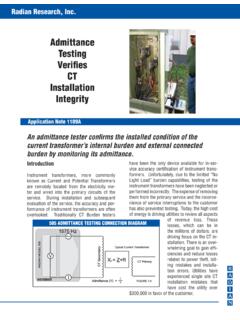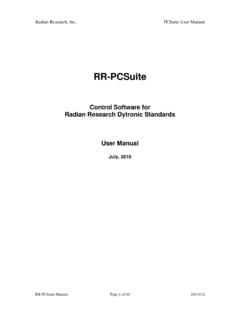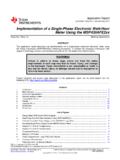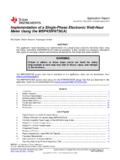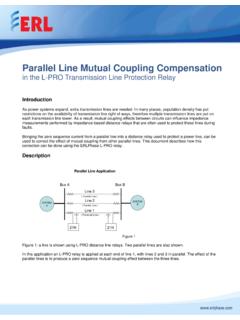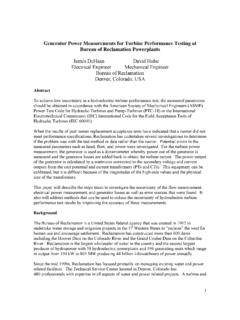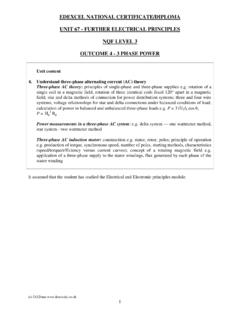Transcription of Impact of Harmonic Current on Energy Meter …
1 2010 NCSL International Workshop and Symposium Impact of Harmonic Current on Energy Meter calibration Speaker: Steven Weinzierl, Radian Research, Inc., 3852 Fortune Drive, Lafayette, IN, 47905, USA, (765) 449-5548, Authors: Shannon Edwards, Dave Bobick, and Steven Weinzierl, Radian Research, Inc. Abstract: This paper compares and contrasts different methods to quantify VAR for single and polyphase Energy meters . The results for the different methods will be compared in the presence of different realistic Harmonic content scenarios, with sometimes a 30x difference seen in results between the methods. By understanding the differences between VAR methodologies in the presence of harmonics , we can take the next steps towards metrology consensus and standardization on how to measure and calculate them. 1. Introduction As countries update their Energy policy and infrastructure and increase investment in smart grid technologies, there is greater awareness of power and Energy measurements.
2 With that comes greater awareness of the increasing gap between consumed real power (watts) and generated apparent power (VA). Furthermore, as electronic devices become more sophisticated with increased semiconductor content, there is a rapid proliferation of highly non-resistive and non-linear loads. In fact, many of these new non-resistive and non-linear devices are Energy -conserving devices such as dimmers, Energy -efficient motors in new appliances, and compact fluorescent lights that are being deployed as part of the new Energy policies. Historically, reactive power (VAR) has been used to quantify the gap between consumed real power and generated apparent power of an AC electric power system [1]. Reactive power comes from 2 main sources: 1. Phase angle difference between the voltage and Current sine waves, primarily due to non-resistive behavior such as device inductance or capacitance.
3 2. Waveform distortion from non-linear behavior, primarily due to Harmonic content. VAR is easy to determine in the first case of phase angle (non-resistive) contribution via a scaling factor of sin( ); therefore there is consensus among metrologists and measurement experts on how to quantify it. However, VAR in the second case due to Harmonic currents from non-linear loads is more complicated. Combined with the fact that reactive power in general does not transfer Energy , there is a lack consensus amongst metrologists on how to measure and calculate VAR in the presence of Harmonic content. Ironically, the issue is further compounded by the observation that compared to older electromechanical meters , newer solid state meters have much smaller measurement error of active Energy (watts) when supplied with active Harmonic Energy [2].
4 However, the solid state meters have shown widespread variation in VAR results, hence a call for for an urgent international agreement [2]. Because the utilities that produce Energy need to build expensive base or peak generation plants based on VA and are beginning to charge consumers based on the VAR component, it is an important issue of fair commerce for a consensus to be achieved amongst metrologists. 2010 NCSL International Workshop and Symposium This paper will: Compile and review the most common VAR calculations. 9 different ones are identified and discussed. Propose 6 representative waveforms (theoretical and actual recorded) with differing levels of harmonics in them to compare the results of the 9 different VAR calculations. Contributions from harmonics out to the 100th order are included. Compare the results of the 9 different VAR calculations across the 6 different representative waveforms.
5 Make suggestions for next steps on how to proceed. 2. Compilation and review of best-known VAR calculations Because there is no standardized nomenclature, the names for the methods were created by the authors and are now being used within the ANSI committee. The 9 identified VAR calculations are classified into 3 broad types: Pure fundamental calculation appropriate for a pure sinusoidal which by definition includes the effects of only the first Harmonic and discards contributions from higher Harmonic orders. Phase shift calculations. This category has 5 variants within it: o Integral Phase Shift Method Fixed Frequency o Integral Phase Shift Method Exact Frequency o Differential Phase Shift Method o Quarter Cycle Delay Method o Cross Connected Phase Shift Method Vector calculations. This category has 4 variants within it: o Vector Method using VA RMS o Vector Method using VA Average Responding o Vector Method using VA RMS & Fundamental Waveforms A glossary of symbols used in the formulae is given at the end of the paper.
6 Fundamental calculation VARs for each element are calculated by multiplying the fundamental of the voltage times the fundamental of the Current times the sine of the phase angle between them: )sin(||~||||~||iiiiIVVAR = Where the fundamental RMS Voltage and Current are calculated: dtVkTVkTii += 2~1||~|| and dtIkTIkTii += 2~1||~|| 2010 NCSL International Workshop and Symposium Phase shift VAR calculations The genesis behind this calculation type is primarily historical: Early analog electromechanical meters could only measure active (real) watthours. By introducing a known reactive element (typically capacitor and resistor network) into the circuit to create a known 90 phase shift on the voltage axis, the watt-hour measurements of the Meter could in essence be tricked into measuring the reactive component. The added reactive element made the reactive portion of the power active so the Meter could measure it, and made the active part reactive to be invisible to the Meter .
7 Once two sides (watts and VARs) of the power triangle are known, the third (VA) can be easily calculated from the power triangle as shown in Fig. 1 [3]: Figure 1 While the phase shift method was a resourceful way to make the best use of available technology at the time, this method has shortcomings because the selection of the C and R values are frequency specific: Although the phase shift was correct, it would cause amplitude distortion as frequency changed. The proliferation of the phase-shift techniques was the result of future more sophisticated iterations of it to minimize its shortcomings. Within the phase shift methods, there are integral (integration) methods and differential (differentiation) methods. The concept is based on: sin cos and cos , integrating the voltage axis gives a 90 phase shift. Differentiation works in a similar manner.
8 However: Integration attenuates the amplitude of the harmonics Differentiation amplifies the amplitude of the harmonics With both, the amplitude distortion is proportional to the frequency. So while the phase shift was achieved, it was at the expense of amplitude distortion. These methods then renormalize the amplitude of the integrated (phase-shifted) voltage to create a voltage whose fundamental voltage would be identical in amplitude to the fundamental component of the voltage axis. Originally the frequency could not be measured in real time so a fixed value (60Hz or 50Hz as appropriate) was assumed; later the frequency was measured and used in the calculation or the equivalent R and C values were assigned adaptively in real time. 2010 NCSL International Workshop and Symposium The equation for the Integral Phase Shift Method Exact Frequency method is: dtdtVIkTVARikTii = + Substituting (2 60) or (2 50) as appropriate for gives the formula for Integral Phase Shift Method Fixed Frequency.
9 The equation for Differential Phase Shift Method is analogously: dtdtdVIkTVARikTii = + 1 The Quarter Cycle Delay Method could be digitally implemented with charge-coupled devices to achieve the phase shifting. Its advantage over the earlier integral/differential phase shift methods is that it doesn t Impact the amplitude. Compared to the integration method, it appeared to periodically flip the sign of a given Harmonic s contribution, and so more often than not will make the VAR calculation be more negative. Its equation is: dtTtVtIkTVARikTii)4/()(1 = + Finally, the Cross Connected Phase Shift Method is based on creating a voltage that is 90 delayed from the voltage axis and adjusting the amplitude to match the amplitude of the voltage axis input. The 90 delay is created by subtracting the voltage phase that is 240 behind from the voltage phase that is 120 behind.
10 The amplitude is then adjusted by dividing by 3. This phase shift and amplitude adjustment assumes that the voltages are balanced and spaced 120 apart. VARs for each element are calculated by multiplying the 90 -delayed amplitude-adjusted voltage times the Current and integrating over the fundamental period: []dtxVIkTVARikTii += Where the 90 delayed and amplitude corrected voltages are: ()32133 VVxV = , ()13233 VVxV =, ()21333 VVxV = This method has been used extensively in 3-phase electromechanical meters . Its biggest shortcomings are: The assumption of balanced voltages across the phases. This is rarely true, giving the wrong amplitude value in the calculation. The assumption that the voltage phases are exactly 120 apart (rarely true). Vector VAR calculations These methods are all based on measuring VA and Watts, and calculating VAR for each phase from the power triangle (Fig.)
